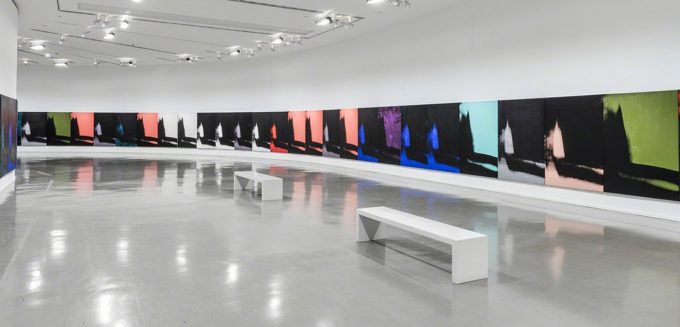Today, in our article, we will not tell an anecdote but a passage of witnesses, a legacy that strikes for what these two artists have in common, despite the differences in their lessons. To hand over the suggestion for today’s story is a photograph. Taken in 1974 by Gianfranco Gorgoni, the snapshot portrays together Giorgio de Chirico and Andy Warhol. The extraordinary nature of this picture and the good fortune that characterizes it are that, in an allegorical revelation that allows us to substantiate, de Chirico transmits to Warhol his conception of the shadow. Interiorized, mature and conscious, this vision of de Chirico’s shadow world is the result of a meticulous and hyeratic metaphysical search where the shadow element is characterized by a moment, by a story. The Italian master seems to govern with consciousness and stillness a truth that flusters the still young Warhol; a truth that he will exorcise and dismember in an even more breathless and neurotic, almost spasmodic quest. Four years after the shot, in December 1978, Wharol will present to the public one of his series: Shadows. De Chirico died only a month earlier. The prelude to this presentation was therefore the death of the master of metaphysics; the shadows, collected for the last time around the, by that time, a ninety years old master, are leaving him to permanently reside in Wharol’s popular art. He will conceive them in the total absence of the pictorial tale by substituting the supernatural character of which they were infused into de Chirico’s metaphysics with a desacralizing seriality. The same Warhol, a year later, releasing an interview with Achille Bonito Oliva, expressed himself so on de Chirico: “I liked his work very much. I like his art and the idea that he has always repeated the same paintings. I really like this idea and I said it would be great to do it.”
The shadows found in Warhol their means of artistic reproduction.
In the monumental series named Shadows, conceived as a single painting divided in more parts, with 102 screen-printed canvases (like the tape of a cinematographic film), the artist presents another puzzle to be solved, hidden behind the mechanical repetition of the one image alone (both in its positive and negative versions).
Even if, at first sight, it may seem insignificant, repetition in Andy Warhol’s art speaks for itself, it speaks of a world of appearances, a world where the metaphysical aspect loses its value, so it is never a mere reproduction of the popular culture as usually is interpreted. Indeed, his art conceals a criticism of this mass-consumer society, where the mysticism and philosophical research, present in Giorgio de Chirico’s paintings, disappears, giving way to popular products and new lifestyles. To confirm this, there is also the statements of the artist who, while answering the question about this achievement, stops at the superficial fact such as: “I went to the disco during its painting, and I imagine that a disco decoration should be done in this way”. A simple phrase like this reflects the problematic analysis of Warhol’s art synthesized – among other things – in his famous phrase: “Everything is art and nothing is art”, thus advocating its very personal philosophical reflection.
A proper clarification: we do not like to use the dates of an artist’s death to take the lead in our stories; hardly death can describe a significant event to tell something about the life of a human being and more specifically of an artist. What their work represents is something that anticipates and overlaps the horizons started and ended with births and deaths. Today’s case is therefore an extraordinary case, so far unique, but, in its extraordinary nature, it respects what we now consider to be our own personal rule. De Chirico perished on November 20th 1978 in Rome. In the day before his departure, an alien shadow, even to his art, puts him in its hands: it is the shadow of death that will take him only few hours after. Earth shadows, as far as they may be in the metaphysical conception of the artist, reject this companion but, in the art world, they find new expression and life in Warhol, as metaphysical shadows perish with their creator.
Certainly, we can not prove that on November 19, 1978, beyond the sensitive experience, has bean given there for a transition of the concept of shadow in the art world. Certainly, however, we want to offer our tribute to de Chirico through a vision that tries to go beyond its death and the physical nature of things.
And if it is true that we have no evidence to say what we have said, who would have them to say the opposite?
Andy Warhol
Shadows
1978
Silkscreen on canvas
102 canvases 190 x 125 cm
Bilbao, Guggenheim Museum
